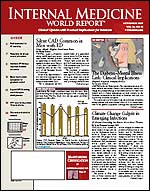Publication
Article
Internal Medicine World Report
Investigation Agent Effective in Reducing Persistent Angina
Investigation Agent Effective in Reducing Persistent Angina
By Wayne Kuznar
Dallas—An antianginal agent in phase 3 clinical studies, ranolazine (Ranexa; CV Therapeutics) reduces anginal frequency in patients with coronary artery disease (CAD) whose angina does not resolve despite daily treatment with amlodipine (Norvasc), said Peter Stone, MD, lead investigator of ERICA (Evaluation of Ranolazine in Chronic Angina) trial and codirector of the Samuel A. Levine Cardiac Unit at Brigham and Women’s Hospital, Boston, at the American Heart Association’s Scientific Sessions 2005.
Ranolazine is the first of a new class of agents called the pFOX inhibitors that are believed to work by partial inhibition of partial fatty acid oxidation and reciprocal increases in glucose oxidation during periods of myocardial stress.
Consistent with this mechanism, ranolazine does not have clinically significant effects on heart rate or blood pressure. “Ranolazine has a novel pharmacodynamic profile with anti-ischemic properties that do not depend on changes in determinants of myocardial oxygen demand, making it an effective complimentary therapy to existing agents that depend on hemodynamics,” said Dr Stone. “It improves the manifestations of ischemia, such as myocardial stiffness and increased wall tension.”
Included in ERICA were 565 patients with a documented diagnosis of CAD who had at least 3 anginal attacks weekly, despite already taking the maximum labeled dose of amlodipine (10 mg/d). Patients were randomized to ranolazine, 1000 mg twice daily, or placebo. Of those enrolled, 45% of patients were taking nitrates at baseline.
Compared with placebo, ranolazine significantly decreased the mean number of weekly anginal episodes (P = .028), improved the anginal frequency component of the Seattle Angina Questionnaire (P = .008), and reduced mean weekly nitroglycerin consumption (P = .014).
A consistent treatment effect of ranolazine was evident across the subgroups analyzed: users versus nonusers of long-acting nitrates, men versus women, and patients aged <65 versus those aged ≥65 years.
Study drug-related adverse events were more common in the ranolazine versus the placebo group (21% vs 6%), but serious events occurred in only 1% of each group, and only 1% of patients in each group withdrew from the study because of adverse events.
As a single agent, ranolazine was shown previously to be at least as effective as atenolol, 100 mg/day, in reducing the frequency of angina, the time to 1 mm of ST-segment depression, and improving exercise duration, Dr Stone said.
In another study, having angina in the 6 months following myocardial infarction (MI) was associated with lower treatment satisfaction, said Mary E. Plomondon, PhD, of Denver VA Medical Center.
She collected data from the index hospitalization and at 1 and 6 months among 1815 patients with MI from 19 US centers. Angina burden was measured at 1 and 6 months, using the Seattle Angina Questionnaire, and treatment satisfaction was measured using the questionnaire at 6 months.
Patients with angina at 1 and 6 months were more likely to report depressive symptoms and less likely to have undergone coronary artery bypass graft surgery at the index hospitalization.
Compared with patients with no angina, those with new angina were 3 times as likely to be dissatisfied with their treatment at 6 months, and those with persistent angina were 3.3 times as likely to be dissatisfied.
According to Dr Plomondon, these findings suggest the importance of angina management after MI to maximize patient satisfaction and thereby quality of care.
